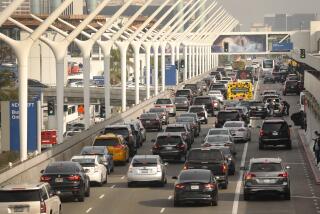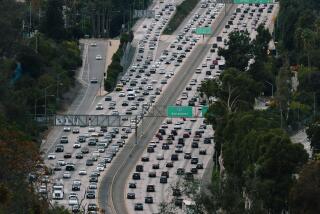Travel Time for Commuters Up Sharply in Year : Traffic: Survey finds time on the road has increased 10 to 15 minutes while covering the same distance to work. In the Southland, 79% still drive to their jobs alone.
Fueling claims that the region’s traffic jams are worse than ever, a survey of Southern Californians who commute to work has found that the average trip, while covering the same distance, has gotten 10 to 15 minutes longer in just one year’s time.
The study, to be released today, also found that rush hour is becoming longer, drivers are becoming more pessimistic about traffic conditions, and there is more awareness of alternatives available to employees--from flexitime to working at home.
But the State of the Commute Report found that a whopping 79% of Southern California’s residents are still driving to work alone in their cars--a number that decreased by a mere wisp from the previous year. Only 14% car-pool; 4% use public transit.
The report is sponsored by Commuter Transportation Services Inc., known as Commuter Computer.
“Ultimately, it is the individual commuter, making a decision to somehow change his or her commute, who is going to have the greatest impact on our transportation picture,” the report stated.
The survey questioned 1,254 randomly selected commuters by telephone in 1989. While the vast majority of those polled lived in Los Angeles County, commuters from Ventura, San Bernardino, Riverside and Imperial counties were also included. A 2.8% margin of error was reported.
The previous year’s study had surveyed 500 commuters in the same counties, excluding Imperial, with a 4.5% margin of error.
Among its results, the survey found that the median trip to work was 30 minutes, 10 minutes longer than in 1988. The median trip home from work was 40 minutes, compared to 25 minutes in 1988.
Distances remained fairly constant, however: 10 miles in 1989, nine miles the year before.
“The alarming fact that it takes 10 to 15 minutes longer than last year to make almost the exact same commute should be enough to convince even Pollyanna that we need to address this problem immediately,” the report’s authors wrote.
“Our system cannot handle the volume of cars and trucks it currently must hold, not to mention the 3 million or so people expected to move here in the next decade.”
Caltrans last surveyed commute times in 1989, using 1987 data. It showed an average commute time of 24 minutes. But a spokeswoman said she had no reason to doubt the accuracy of the Commuter Computer results.
Jim Sims, president of Commuter Computer, conceded that the survey did not measure people’s commutes but rather their perceptions of their commutes. And while many Southern Californians in the past have tended to underestimate the time it takes to drive to work, Sims said he believes commuters are now becoming more accurate in estimating their travel time.
“Simply,” Sims said, “there are more cars on the road, and it is taking longer” to get anywhere.
Commuter Computer, which conducted the survey with the Southern California Assn. of Governments, is a nonprofit transportation research group that promotes ride-sharing. It is endorsing Proposition 111, a ballot measure that, among other things, would increase the state’s gasoline tax by 5 cents per gallon to help finance construction of new roads and mass transit facilities. But Sims said release of the survey was coincidental.
For respondents to the survey, rush hour is starting earlier and ending later. The percentage of people who arrived at work before 7 a.m. had nearly doubled--from 15% to 28%--while 13% leave work after 7 p.m., compared to only 8% in 1988. At the same time, more people were leaving before 4 p.m. than in the previous year to avoid peak-hour traffic.
As a result, freeways are congested for a longer time, Commuter Computer concluded.
The survey also showed that, while car-pooling and van-pooling are the most appealing alternative modes of transportation, commuters were less interested in trying them than they were a year ago.
In 1988, 37% of the respondents said they “definitely would try” a car pool. But in 1989, only 16% gave the same answer.
Labeling the trend “alarming,” the report suggested that some commuters, as they learn more, have become “more realistic” in deciding whether alternative transportation will work for them.
Awareness of the kinds of alternatives that are available has grown, the report concluded. Many more workers than in the previous year stated that their employers offered or encouraged use of flexible work hours, or flexitime, car and van pools and subsidized bus passes. About 26% said they had the option of working at home (“telecommuting”) or working at a satellite office.
Only 7% of those surveyed said freeway traffic had improved over the previous year; 67% said it had gotten worse. At the same time, however, those commuters who say the trip home in the evening was “always good” grew by 8 percentage points to 27%.
Sims said that while commuters have to change their habits, businesses must take the lead in encouraging their employees to do so. The health of Southern California’s economy depends on it, he maintains.
“Highly skilled and trained (workers) have choices,” Sims said. “If we don’t make the commute tolerable, their choice will be to move out of the state or out of Southern California.”
COMMUTING IN SOUTHERN CALIFORNIA
Selected data from the 1989 Commuter Computer survey on Southern California commuting habits, as compared to 1988 study: METHOD OF TRANSPORTATION
Mode 1988 1989 Difference Drive alone 83% 79% -4% Carpool 11% 14% +3% Public bus 2% 4% +2% Other 4% 3% -1%
DISTANCE AND TIME TO WORK
Distance in Miles 1988 1989 Difference Under 5 19% 22% +3% 5 to 9 23% 22% -1% 10 to 14 17% 15% -2% 15 to 19 13% 11% -2% 20 to 24 10% 10% 0% 25 to 29 5% 5% 0% 30 to 34 3% 3% 0% 35 to 39 2% 2% 0% 40 to 44 1% 2% +1% 45 and over 7% 8% +1%
The median distance to work in 1988 and 1989 was 10 miles, according to the survey. The median time commuting to work in 1989 was 30 minutes--10 minutes longer than in 1988. The median time commuting to home in 1989 was 40 minutes--15 minutes longer than in 1988.
More to Read
Sign up for Essential California
The most important California stories and recommendations in your inbox every morning.
You may occasionally receive promotional content from the Los Angeles Times.











